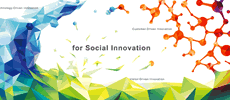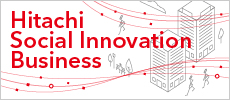AbstractResearch and Development at HitachiResearch and Development
The world is currently experiencing “polycrises,” where the challenges facing society such as supply chain risks, worsening labor shortages, and urgent environmental issues are interlinked. In this context, the roles of corporations are becoming increasingly diverse. At the same time, industries are increasingly undergoing a rapid structural transformation driven by the widespread adoption of technologies such as generative artificial intelligence (AI). It this environment, Hitachi aims to achieve societal sustainability and foster growth in partnership with its customers by creating value through innovation. FY2024 marks the final year in Hitachi’s Mid-term Management Plan 2024, which sought to advance its Social Innovation Business through the themes of “green,” “digital,” and “innovation.” The year saw significant achievements across multiple areas.
The Research & Development Group plays a central role in driving innovation at Hitachi. By leveraging technologies such as generative AI, the Group focused on two core strategies, “transforming customer experience” and “addressing the fundamental issues facing society” to create new value, drive innovation and advance Hitachi’s Social Innovation Business. The Group is also actively advancing its technologies and intellectual property (IP) in areas such as robotics, quantum technology, biotechnology, and generative AI. It is also fostering open innovation through collaboration within ecosystems to facilitate the practical application of cutting-edge technologies. Through such efforts, Hitachi aims to tackle the challenges faced by both its customers and society at large, to achieve sustainable growth. This section highlights key research and development initiatives driving innovation.
Technologies Underpinning Generative AI
Developments in generative AI are advancing rapidly and have become a driving force for innovation. It is expected to create new business opportunities and significantly enhance operational productivity in both the short and long term. Generative AI is also expected to transform infrastructure and workplaces, accelerating change in work practices in manufacturing as well as in the office. Work by the Research & Development Group on generative AI is covered in this section, beginning with a column on “Hitachi’s Research into How the Metaverse, AI, and Robotics Can Assist Frontline Workers.” Workforce shortage is emerging as an increasingly serious problem for society, and the column describes how new values are being created through the comprehensive application of technology.
This section highlights technologies and solutions that enable the use of generative AI. Key areas of focus include, generative AI applications in system development, a multi-modal platform model, customized large language models (LLMs), and coupled learning for distributed AI. Additional solutions described include software updating and knowledge management for manufacturing and other industries. The articles share examples of how Hitachi is integrating generative AI with its expertise in mission-critical systems for societal infrastructure to deliver value.
The growing use of generative AI also presents challenges, such as shortages of semiconductors, data centers, and electricity. Many of these issues are being addressed through Hitachi’s ongoing work. Additionally, the spread of AI is raising ethical concerns. To address these concerns, Hitachi established principles in February 2021, to ensure the ethical, human-centric development and deployment of AI technology in its Social Innovation Business. The company has also created usage guidelines for generative AI to ensure that risks are managed appropriately.
Innovation to Transform Customer Experience
The challenges faced by customers and businesses continue to evolve with the changes in society and the environment. To achieve sustainable growth, Hitachi is working with customers to develop growth scenarios and engage in green transformation (GX) and digital transformation (DX) activities. The Research & Development Group aims to strengthen the Lumada growth cycle by leveraging resources such as the Kyōsō-no-Mori open innovation hub and its global network of research centers. These facilities enable collaborative discussions with customers and close coordination with Hitachi’s operational divisions. Together, they develop and deliver solutions that integrate information technology (IT), operational technology (OT), and product expertise to address customer needs worldwide.
The Digital Systems & Services sector is highlighted through case studies on the digital transformation of customer operations and societal infrastructure. Examples include, IT systems such as hybrid cloud platforms, high-performance compression techniques for digital storage, and secure system solutions such as trusted execution environments (TEEs) to process confidential information. Another topic covered is data center management in North America. Collaborative efforts to address societal challenges are also featured, such as an evidence-based policy-making (EBPM) business platform that supports local governments in implementing preventive care services.
From the Green Energy & Mobility sector, the articles describe Hitachi’s contribution to the growing decarbonization market by helping customers improve infrastructure efficiency. Key initiatives described include, energy management technologies, such as optimizing energy use in mid-sized equipment and the development of a carbon-neutral navigator. For nuclear power generation, Hitachi is advancing technologies such as a cycle scenario simulator for the resource-recycling boiling water reactor (BWR) and providing digital solutions to support the safer restart of plants. For the railway industry, the topics covered include technology to optimize traffic planning to improve energy efficiency and reduce costs. Additionally, it is driving the digital transformation of manufacturing at its rolling stock production facilities.
The section on the Connective Industries sector focuses on solutions for growth markets in industry and healthcare, as well as the product technologies that underpin them. Key topics include a simulator to help advance a circular economy and battery industry technology for use and recycling. Digital solutions such as factory configurators and automation techniques for warehouses are also highlighted. In the semiconductor field, Hitachi is working to enhance testing and measurement equipment, an area gaining momentum due to the rapid growth of generative AI. Healthcare topics include, testing techniques for infectious diseases, while product innovations cover energy-efficient compressors, motors, elevators and the manufacturing techniques that support these advancements.
Innovations Addressing Fundamental Issues Facing Society
Hitachi’s efforts to address the fundamental societal issues, include research and development based on backcasting from a vision for society in 2050. The work focuses on six areas: For an “environmentally-neutral society” (1) the integrated supply of electricity, gas, and hydrogen, and (2) the conversion of CO2 into a valuable resource;” for “a society that supports an active 100-year lifespan,” (3) the development of particle beam therapy, (4) advancement in cell design, production, and inspection practices, and for the “co-evolution of digital technologies, people and society,” (5) the establishment of a digital observatory and (6) quantum computing applications. This section carries articles describing hydrogen production systems, synthetic biotechnology for achieving carbon neutrality, the development of a platform for designer cells, a digital observatory, and work on quantum computing.
Addressing future societal challenges will require collaboration within business ecosystems to develop and implement new technologies. To this end, Hitachi is fostering open innovation by strengthening partnerships with academia and startups. Examples include activities of the Hitachi-UTokyo Laboratory, Hitachi Kyoto University Laboratory, and Hitachi Hokkaido University Laboratory, as well as the “Future City” pavilion at Expo 2025 (Osaka, Kansai, Japan*).
The articles in this category highlight a selection of research and development initiatives aimed at building a sustainable society that respects planetary boundaries and enhances people’s well-being. Alongside its ongoing efforts to develop technologies, the Research & Development Group plans to accelerate collaborative creation with customers and expand open innovation to facilitate the societal implementation of these technologies.

![[01]Research and development initiatives driving innovation](/rev/archive/2025/01/abstract/image/fig_01.png)


